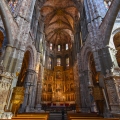The Holy Sepulcher, located in the Old City of Jerusalem, is considered the holiest site in Christianity. It is believed that crucial events of the Passion, Death and Resurrection of Jesus Christ occurred at this site, including his crucifixion on Calvary (Golgotha) and his subsequent burial and resurrection. The present church incorporates these sacred sites, being a major pilgrimage destination since the 4th century. The Basilica of the Holy Sepulchre complex has been guarded by various Christian communities over the centuries, including the Catholic Church, the Greek Orthodox Church and the Armenian Apostolic Church.
The history of the Holy Sepulcher is marked by a series of destructions and reconstructions. Since its construction by order of Emperor Constantine the Great in the 4th century, the temple has been subject to attacks, fires and earthquakes that have caused significant damage over the centuries. Despite these adversities, the site has been restored and renovated on multiple occasions, maintaining its importance as a spiritual center and place of pilgrimage for the Christian faithful from all over the world.
The Holy Sepulchre is also known for the “status quo”, an agreement that establishes the division of ownership and responsibilities among the different Christian communities that guard it. This agreement, which dates back to the 18th century, has been instrumental in maintaining peace and stability at the site, ensuring that religious disputes do not interfere with devotion and worship at this sacred site. Despite the political and religious tensions in Jerusalem, the Holy Sepulcher remains a symbol of unity and faith for Christians around the world.
In addition, within the Holy Sepulchre complex, there are five stations of the Via Dolorosa, the path that according to Christian tradition Jesus Christ walked carrying the cross to the site of his crucifixion.
The tenth station, the stripping of the garments, is located just as you enter the church going up Golgotha, and recalls the moment when Jesus was stripped of his clothes before being crucified. The eleventh station, the crucifixion, is near the tenth and marks the place where Jesus was nailed to the cross. The twelfth station, the death on the cross, takes place at the Orthodox altar of Golgotha. The thirteenth station, the descent from the cross, is located between the two previous stations and includes the Stone of Anointing, where the corpse was anointed. Finally, the fourteenth station, the burial in the tomb, marks the place where Jesus was placed in the tomb after his crucifixion, which today is the aedicule.
-
- Address
Holy Sepulchre, Jerusalem - Web
None - Visiting Hours
Unknown - What to see
Tomb of Christ, Golgotha, Adam’s Cave, Stone of Anointing
- Address




